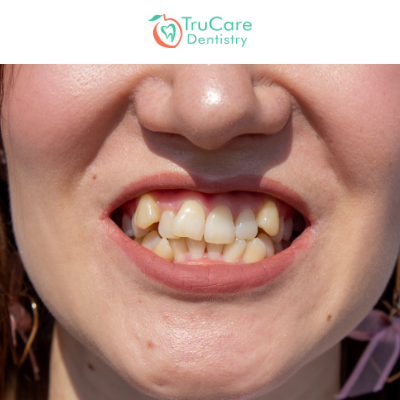Teeth misalignments can cause severe problems while breathing, speaking, eating, or brushing. It can affect one’s physical appearance as well as overall health and psychological wellbeing. Many Americans face the problem of teeth misalignment.
As per some estimates, temporomandibular disorders affect more than 10 million Americans. When left untreated, they can result in further complications and cause severe problems. That’s why it is extremely crucial to know the types of misalignments, their causes, and the treatments.
Types of misalignments
- Overbite: This misalignment occurs when the top front teeth overlap (or extend farther) the bottom front teeth. This is also called bucktooth.
- Underbite: In this, the lower teeth overlap (extend beyond) the upper teeth.
- Openbite: In this, the top and bottom teeth do not touch each other properly and it leaves a gap even when the jaw is closed.
- Crossbite: In this, the top teeth do not align correctly with the bottom teeth.
- Crowded teeth: In this, teeth overlap, bunch up, and twist, and do not have enough space to fit properly.
Causes of misaligned teeth:
- Family history and genetics
- Premature loss of milk teeth
- Thumb or fingers sucking
- Accidents involving the jaw
- Gum diseases
- Unusual teeth size and shape
- Oral tumors
How to fix misaligned teeth
Here are some treatments for misaligned teeth:
- Braces
There are two types of braces—metal and ceramic. The former is one of the oldest and most common fixes for misaligned teeth. The small metal brackets are gray or metallic silver in color and are effective for severely misaligned teeth. The latter is quite similar to the metal braces except for the color. They are clear or tooth-colored brackets that align and straighten the teeth. Dentists attach these braces using dental adhesives and tighten the brackets using orthodontic wire. - Invisalign
Invisalign are transparent aligners that are custom-made for every user. Due to their transparent surface, these braces don’t get noticed. Users can remove it whenever they want and they must take these off while brushing or eating. These transparent braces are extremely suitable for temporary use. Dentists, however, recommend users wear it for 22 hours every day. If you are looking for Invisalign braces in Roswell, GA, contact TruCare Dentistry. - Dental implants
Dental implants are metal fixtures that replace the root portion of a missing tooth. These are usually made from titanium and provide permanent solutions for missing teeth. In this procedure, dentists insert an implant into the jawbone with a screw-like device and replace the missing tooth with a metal crown. These have an extremely high success rate of over 95 percent and provide users with better quality of life. However, people with dental implants need to take good care of their teeth without which they are likely to experience complications such as infections, tissue, and nerve damage. - Dental bridges
Unlike dental implants, which are metal tooth roots, dental bridges are false teeth that cover one or more missing teeth. These are useful for a person with one or several missing teeth. Compared to dental implants, these cost less and require less time for the procedure. On the downside, however, these need to be replaced more frequently. While an implant can last longer than 40 years, a dental bridge is likely to last 10 to 20 years before it is replaced. - Dental splints
Dental splints are devices that are designed for people who grind their teeth. The mouth guards and bite plates are used to treat temporomandibular disorders for short periods. People with the disorder use it during sleep and it does not result in permanent changes in the jaw or teeth. It is, however, not the same as a mouthguard. Unlike a mouthguard, it holds the teeth to prevent harmful movement. Apart from clenching and grinding, the appliances also benefit the teeth that have become loose due to lost gum tissue as it attaches weak teeth. - Dental veneers
Also called porcelain veneers and dental porcelain laminates, dental veneers are chip-like materials that a dentist place on the sides or surface of the teeth. It is a good option for people who have a minor misalignment in their front teeth. These can last between 10 and 30 years. Before putting the laminates, the dentist creates a proper structure and after that - Orthodontic headgear
Orthodontic headgear is a dental device that supports jaw alignment and corrects bite. Introduced in the nineteenth century, the appliance is one of the oldest treatments still used today to treat overbites. The orthodontic headgear is strapped to a patient’s neck or head with one or many straps. After this, the force gets transferred to their jaws or mouth and they can easily eat their food properly. - Palate expanders
Palate expanders are dental devices that widen the palate (or the roof or upper jaw of the mouth). The orthodontic appliances are useful in correcting the misalignment between the two jaws. Palate expanders are effective at a young age. Dentists use the devices on children and teenagers before they start other dental procedures. - Dental surgeries
Dental surgeries encompass several types of dental procedures starting from the ancient technique of tooth extraction to the modern procedure of laser surgery. It involves surgery of teeth, corrective jaw surgery, bone grafting, gum treatment, and more.
In sum,
There are broadly five types of teeth misalignment, which can occur due to several reasons. But the good news is, it is completely treatable. At TruCare Dentistry, we provide a wide range of treatments from dental surgeries to implants to Invisalign braces in Roswell, GA. Are you looking for an experienced and trustworthy dentist in the area? Contact TruCare Dentistry and book an appointment today.

